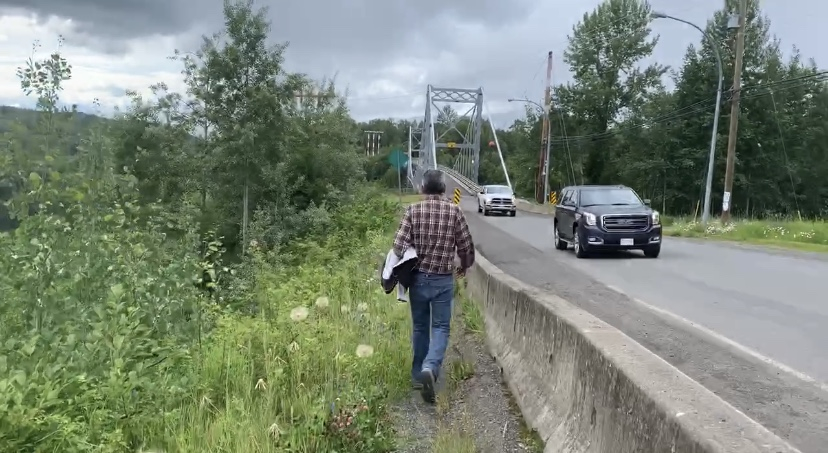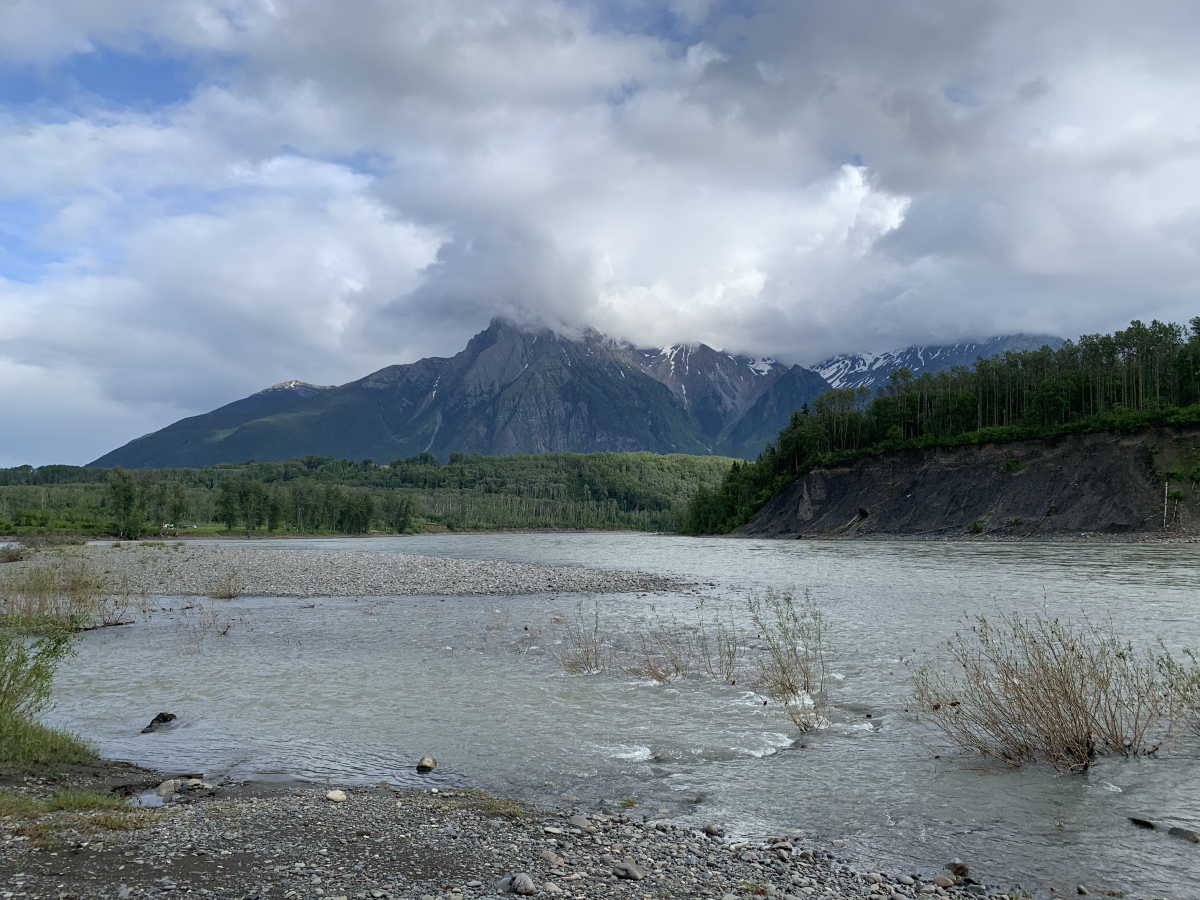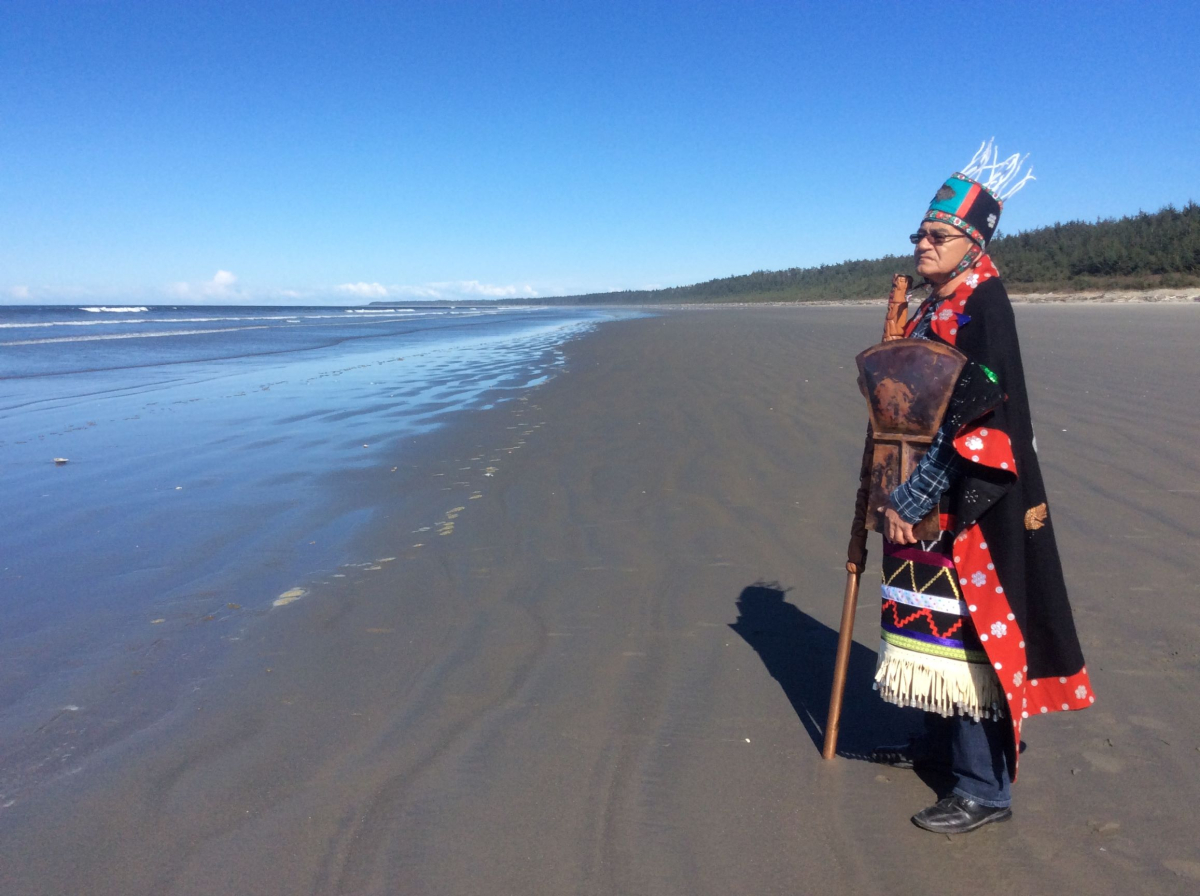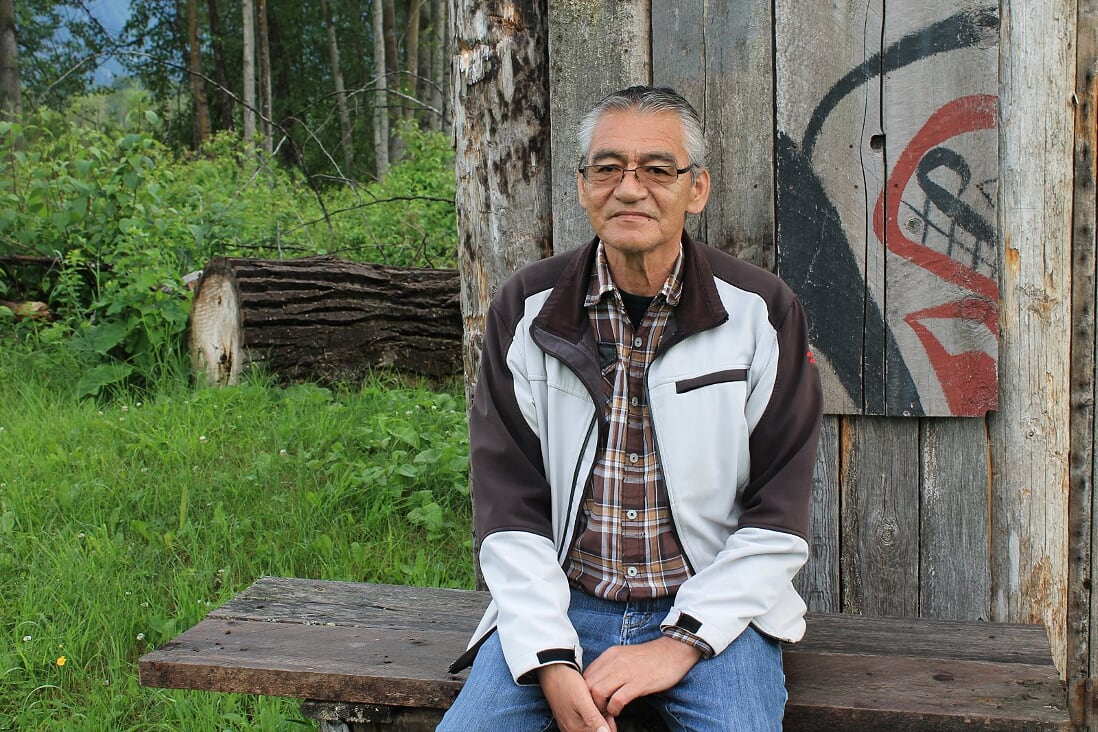I knew I was journeying into a war zone of sorts.
I had watched from afar — online — following play by play the standoff between the traditional Wet'suwet'en People and a multibillion-dollar pipeline project backed by the B.C. and federal governments with armed RCMP enforcement. And I visited this place once before in winter 2019 to meet briefly with a Hereditary Chief named Na’Moks, a.k.a. John Ridsdale.
When I visited last time the conflict from the first wave of the RCMP arresting the Wet’suewet’en land defenders and enforcing an injunction to put through the CGL pipeline had just happened. There was a raid of the Unist’ot’en healing camp in January 2019. I arrived in March on the heels of the first collision the community had with police.
Back then ‘Wet’suwet’en’ was a new name slipping into the headlines. For many Canadians it was the first they had heard of the people, and the place. In the mainstream news they were called protestors. On social media they were calling them terrorists.
Now I was here for a second time. And this time I came this time when the conflict wasn’t dominating the headlines, a sort of calm between uproars. The COVID-19 pandemic had arrived in the world on the heels of the Wet'suwet'en crisis that shut down Canada in February. I arrived when humanity around the globe was - literally - sheltering for our lives during the worst pandemic in the last 100 years.
But while the world went on hold the pipeline conflict didn't end, it's just not in the headlines.
TC Energy is forging ahead with its Coastal GasLink natural gas pipeline in its quest to feed power from northern British Columbia to its facility in Kitimat and then to Asia across the sea.
I’m discovering what’s at stake for the Wet'suwet'en. It’s both simple and complex. It’s not an issue someone can understand just by reading an occasional news article.
And the cost is high.
That cost is the livelihood of the sovereign Wet'suwet'en.
You see, Canada, the province, and the pipeline weaving through the mountainous terrain of the vast, pristine and extraordinary lands of the Wet'suwet'en are on a path that, unchecked, could wipe them out.
It sounds shocking? Not in Canada, right?
Well, this same struggle for survival has been going on for a couple of centuries here.
But the Wet’suwet’en, like all our Indigenous relations, know how to survive. They’ve survived through attempted annihilation via genocide; through colonialism’s oppressive assimilation tactics; land theft; residential school; sixties scoop; racism; and murder via way of Missing and Murdered Indigenous Women and Girls.
Despite this, from what I’ve seen here, the Wet’suewet’en are thriving. They are reclaiming. They are healing. And they are reviving hope, traditions, and land.
The Wet'suwet'en and its five member nations are divided into clans, houses and traditional leadership systems. It's a way of governance they’ve used to sustain their culture, laws, language, spirituality, families and the caretaking of their lands and resources since time immemorial.

The land is Wet'suwet'en
Chief Na’Moks explained to me the Wet'suwet'en are the land and the land is Wet'suwet'en, so if the land is threatened, so are the very lives, spirits and futures of the people whose ancestors walked this land for thousands of years before them.
The water systems here are all connected. The Morice River, which runs mere metres from the path of the pipeline, connects to the mighty Skeena and Bulkley rivers in Wet'suwet'en territories in northern B.C.
Those waters flow to the Pacific Ocean. It’s a highway of intricate ecosystems inhabited by various types of migrating salmon that the Wet'suwet'en have always utilized for sustenance. And the waters flow through other allying tribal territories, such as the Gitxsan Nation.
Those same waters eventually flow to join the salt waters that reach the shores of the Haida People across the ocean.
And in those waters are the salmon that are a part of the land and crucial to the land's survival.
The Wet'suwet'en have ancestral libraries of knowledge running through their veins about this land. And one way they pass knowledge down is through storytelling.

The journey of a chief
"The salmon are in the trees."
That’s what Na’Moks told me when we walked to see the convergence of the Skeena and Bulkley rivers on a cloudy Monday afternoon in early July. He pointed across the water to an area that’s been a gathering place for his relatives in the summertime for as long as their stories have been told him.
He camped there as a child. It was a celebration. And clans and families would meet to harvest fish, trade and feast, sometimes for months on end, he said.
In traditional Wet'suwet'en governance, chief names are given or inherited through the matriarchal line. Holding a name also requires a sacred obligation to uphold the laws of the Wet'suwet'en and protect the land.
According to the Office of the Wet'suwet'en, “Before non-native contact, a Wet’suwet’en heir began their journey to becoming a hereditary chief while still inside the mother’s womb. Elders, shamans and chiefs would often feel the womb of an expectant mother and determine if the baby was destined to be a future chief or shaman. From the time of birth, the child would be groomed or tutored to be a wise, strong and responsible leader.”
When the individual is trained or groomed a decision is made inside the feast hall, which in western world terms may be understood as similar to a parliamentary system, to appoint them to step into their name. A ceremony is held and from then on, a Hereditary leader becomes the name, the values, the responsibilities, the knowledge, the territory assigned to oversee.
It’s not taken lightly. It’s a lifelong responsibility with implications that last into the next seven generations.
Na’Moks, 63, is tall, dark-skinned, with slicked-back brown-grey hair, tinted eyeglasses and wears a plaid, button-up cowboy shirt and jeans. He’s well-spoken and easygoing.
Na’Moks received his name 12 years ago.
“When my grandmother passed, it was to go to my mother. She decided her brother was better prepared, so she requested he carry it until his death. He was to train me in his lifetime, which he did,” explained Na’Moks.
“When it came time for me to lift the name, it was decided by our clan as well as other clans to agree that I was prepared and would carry it properly and protect our territories.”
Since then, Na’Moks has travelled across Canada to raise awareness of threats to the lands here. He helped stop the Enbridge pipeline, and he’s been at the forefront of the current pipeline conflict, although there are four other hereditary chiefs representing the five clans of the Wet'suwet'en.
Na’Moks is the type of man who makes friends easy — or puts people at ease, I guess you can say. His personality is a connector, a storyteller, a joker.
And Na’Moks is fiercely proud of where he’s from.
He’s travelled to the United Nations dressed in his dazzling Tsayu (Beaver) Clan regalia adorned with headdress to plead the case of the Wet'suwet'en and helped negotiate with governments about the land disputes here.
He'll do whatever it takes to help save the Wet'suwet'en from destruction. Yes, it’s that dire of a situation. Lives are on the line.

The salmon are in the trees
“The salmon are in the trees,” he told me. I looked at him puzzled.
He went on. “When the eagles catch the salmon from the river, they take them to eat on the land, by the trees,” he points again and my senses are overwhelmed with the expanse of the scenery I’m standing in.
The diversity is like no other on Earth, he explains. Here you can find cedar trees, spruce and other deciduous plant life adjoining the ridges of the mountains and rivers.
The smell here is indescribable and something you have to experience to truly understand. It’s green. It’s invigorating. And your lungs will take in its fresh gift with thanks.
The towering, snow-capped mountains set against a blue sky painted with fluffy, white clouds is a feast for the eyes. Not to mention the wild flowers and medicines bursting with enchantment and clothing the summer months in their colourful beauty.
The sound of the rushing water, which to Wet'suwet'en and Indigenous cultures is a symbol of life (“water is life” is a common adage we live by), is thunderous, gentle, refreshing and pure.
“When the eagle leaves the salmon bones at the base of the tree, they decompose and go back to the earth.The salmon bones feed the trees, they provide nutrients for them,” said Na’Moks.
I had never known that sort of knowledge and it hit me how it was simple to understand once you see it.
When someone explains it to you, your eyes open. The connection to the circle of life, its sacredness, fragility — the knowledge the First Peoples of their own territories have in their DNA is powerful, it’s healing.
The ancestral wisdom passed through the ages to the Wet'suwet'en is crucial to the maintenance and survival of these lands, waters and everything they’re connected to outside here. Including the people.
Wet'suwet'en traditional leaders like Na’Moks stand against the CGL pipeline because it’s a matter of life and death.
It’s not just one pipeline, Na’Moks explains.
Once they come in, it opens a “Pandora’s box” and other resource developers are waiting in line, he said.
Industry and governments are vying to turn that pipeline route into an energy corridor, he said. A powerhouse of untapped natural resources awaits an incessant hunger for greed, power and unsustainable development to be divided up amongst the world.
It’s not a matter of “if, it’s a matter of when” the pipeline will burst, explained Na’Moks as we continued to walk along the river and back towards an ancient, vivid red and black carved Gitxsan village called Ksan that he took me to visit.
Once that happens, the land will be destroyed. It’s not just a “little accident” when a pipeline spills, he said. That’s what they (industry, governments) will try to make you believe. But once the land, the ecosystems, the waters are contaminated and “poisoned,” it can’t be remediated.

It's heavy. It's heartbreaking.
These are the last of the territories of the Wet'suwet'en that haven't been stolen by colonial governments who sold off the land to European settlers or auctioned them off to industries such as mining and logging that then stripped the earth of her bounty, and they “take too much,” explained Na’Moks.
What’s left is worth protecting now and for future generations, he explains. There’s no other place on Earth that has the ecosystems that exist here.
Wet'suwet'en ancestors drank of the same water, they walked trails and trade routes that are still traceable in the woods, along with ancient village sites and gravesites — gravesites that CGL has already bulldozed over in its initial phases of construction.
“They (CGL) don’t care. I would go to jail if I went and bulldozed a gravesite. They're bulldozing a people … they don’t care.”
It’s heavy. It’s heartbreaking.

To protect and stand for the territory.
Na’Moks knows about resilience. When he was 19, he worked at a sawmill in Houston, about an hour's drive from Smithers, B.C. His work ethic got him promoted to foreman, which “for an Indian'' at that time was a big deal.
Some other workers there didn’t like it, he said.
They were white.
One day after work, they “knocked him out,” tied him up to the back of a pickup with a rope and dragged him along the hard, frozen ground. It broke almost every bone in his body.
They left him there to die.
Crawling naked, because his clothes had been ripped off during the dragging, he made his way under a barbed wire fence and into a ditch.
A woman driving who lived nearby came driving along and saw steam rising from the ground. She pulled over and took her shotgun out because she thought it was an animal needing to be “put out of its misery.”
She aimed and took a closer look — it was John.
She was white, she was a friend, he said. She got him to the hospital.
Na’Moks says he was paralyzed for two years from that incident and had to learn how to walk again.
When he was well, Na’Moks used his savings to buy a fishing boat and moved to Prince Rupert, where he became a fisherman like his father before him. Now he’s retired and dedicates all his time to his purpose: “To protect and stand for the territory.”
He doesn’t hold animosity and forgives people who have wronged him. Like the men who tried to kill him and left him in a ditch. This is the Wet'suwet'en way, to forgive.
“That experience I went through is very singular to what those few guys did. I wouldn’t want what I went through to happen to anybody... they live with the guilt. Right now, they’re probably good parents, good grandparents.”
But it doesn’t mean “we roll over and play dead,” he said.
“It’s our (Wet'suwet'en) right to stand here. If I want to drink that water, I will, because it’s clean. All it takes is one spill and everything collapses.”




Comments
Good article, thanks. Should be read in conjunction with this from APTN National News.
https://www.aptnnews.ca/national-news/weve-got-a-real-divide-in-the-com…
Things are never simple. The Wet'suwet'en have to work this out.
Re” “In the mainstream news they were called protestors. On social media they were calling them terrorists.” The right term is “land protectors”.
How is it possible that we are still at this stage of "evolution" after all these decades. And to enforce this thinking: "there is no such thing as systemic discrimination and racism in our gouvernance". I'm an 85 yr-old white woman, raised "French-Canadian", worked all my life in "English". I am flummoxed by the hypocrisy of our Canadian "Sorry eh!". At the time, I thought Pierre Trudeau was the Trugh Seeker and that his adversorial behavior would straighten all these wrongs. Little did I know. God help us! We're not out of the woods yet and no white man is going to get us out - that I'm convinced of!